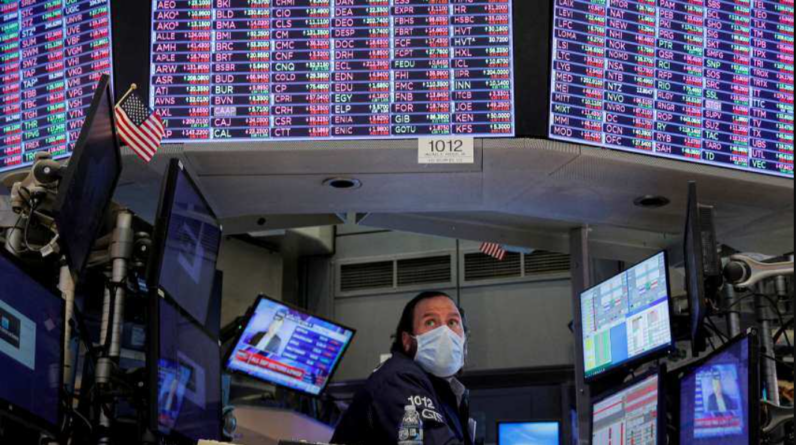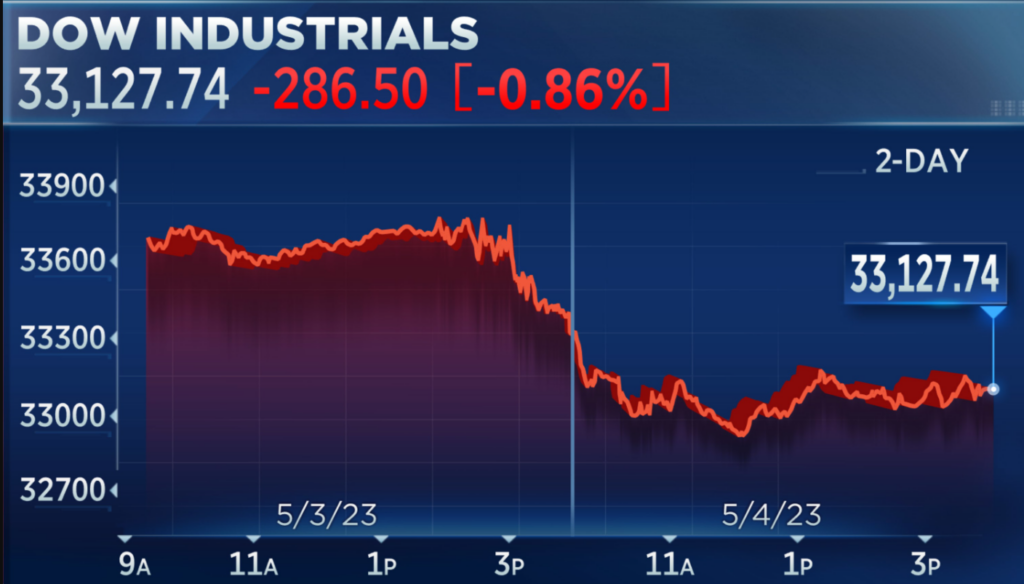
A global measure of stocks declined for the fourth consecutive day, while the dollar advanced, as the European Central Bank raised rates on Thursday and signaled the need for additional tightening a day after the U.S. Federal Reserve also raised rates. Yields on U.S.
Treasuries decreased, while oil prices stabilized following a precipitous decline earlier in the week. In addition to investor unease over central bank communications, Wall Street stock indexes were also under pressure from another sell-off in U.S. bank shares, which have been shaken by the weekend failure of a third major regional bank.
After the ECB, the central bank for the 20 countries that share the euro currency, raised interest rates by 25 basis points to 3.25 percent and signaled that further tightening would be required to combat inflation, European equities closed lower. In contrast to the ECB, the Fed had hinted that its continuous cycle of rate hikes may be coming to an end.
The Dow Jones Industrial Average (.DJI) lost 286.5 points, or 0.86 percent, to 33,127.74.
While the possibility of a pause in U.S. interest rate increases was welcome news for U.S. investors, it implied that the economy is declining, according to Lauren Goodwin, economist and portfolio strategist at New York Life Investments. “This balance between potential interest rate stability and an increase in recession risk is what the markets are trying to digest today,” said Goodwin.

Specifically, the economist viewed the Fed’s reference to tightening credit conditions as confirmation of her forecast of an economic downturn. It is extremely unlikely that we will avoid a recession, said Goodwin. We are clearly headed for a recession in the coming months. The Dow Jones Industrial Average (.DJI) decreased by 286.5 points, or 0.86 percent, to 33,127.74, while the S&P 500 (.SPX) decreased by 29.53 points, or 0.72 percent, to 4,062. The Nasdaq Composite fell 58.93 points, or 0.49 percent, to 11,966.40.
All three main Wall Street indexes recorded their fourth consecutive day of losses. It was the longest losing streak for the Nasdaq since December. The MSCI world stock index (.MIWD00000PUS) fell 0.47 percent, marking its first four-day losing streak since mid-March.
In contrast, emerging market equities (.MSCIEF) increased 0.70 percent following three consecutive declines. Another U.S. regional bank, PacWest Bancorp (PACWest.O), signaled problems a few days after First Republic’s demise, adding to investor anxiety. The S&P 500 bank index (.SPXBK) declined 2.8%, while the KBW regional banking index (.KRX) declined 3.5%.
Tim Ghriskey, a senior portfolio strategist at Ingalls & Snyder, observed that worries about banks and the stricter lending conditions they are now offering have spread to other sectors, such as the Dow Transports index (.DJI), which closed down 1.3%.
“As a result of the banking crisis, credit will be restricted. There will be fewer lenders willing to lend,” said Ghriskey, citing the example of airlines facing higher interest rates and less available credit to purchase new aircraft. The dollar strengthened against the euro as investors absorbed the ECB’s rate rise. The dollar index increased 0.188%, while the euro fell 0.438% to $1.1011. At 134.16 per dollar, the Japanese yen strengthened 0.39 percent against the dollar.

“At this point in the tightening cycle, the monetary policy dynamics are essentially fully priced in.” Now, the focus will be on wagers on when the Fed will begin to ease, how much it will ease, and how that relates to what (other) central banks are doing, according to the chief FX strategist at Scotiabank in Toronto, Shaun Osborne.
Benchmark 10-year and 2-year yields Regional banks and economic data worried investors, lowering Treasuries.
The benchmark 10-year note yield decreased by 3.4 basis points to 3.369 percent from 3.403 percent on Wednesday’s closing bell. The yield on the 30-year bond increased by 0.9 basis points to 3.7243 percent, from 3.715 percent. The yield on the 2-year note fell 17.3 basis points to 3.7656 percent, from 3.939 percent.
After three consecutive days of steep declines, crude oil prices stabilized due to demand concerns in major consuming nations stemming from global economic concerns.
U.S. crude settled down 0.06 percent at $68.56 per barrel, while Brent settled up 0.24 percent at $72.50 per barrel. As U.S. banking concerns accelerated a flight to the safe-haven asset, the price of spot gold reached its highest level in years. Gold on the spot market rose 0.6% to $2,050.66 per ounce. Gold futures in the United States rose 0.95 percent to $2,047.90 per ounce.
